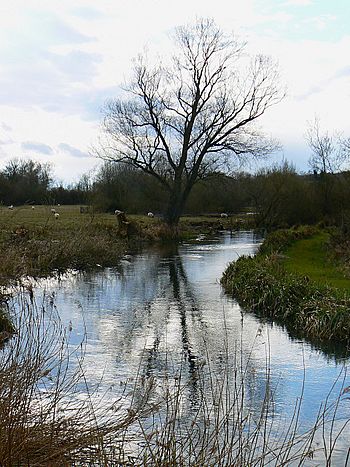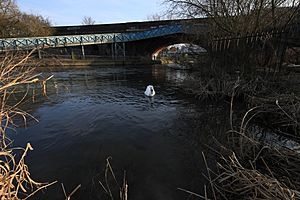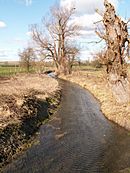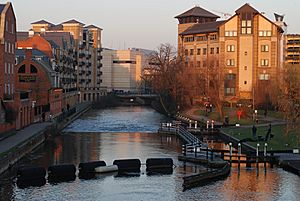River Kennet facts for kids
Quick facts for kids Kennet |
|
|---|---|

The Kennet near Axford, Wiltshire
|
|

The Avon of North Wiltshire and Somerset (to west, left) and the Kennet flowing into the Thames. Linking canal network in red.
|
|
| Country | England |
| Counties | Wiltshire, Berkshire |
| Towns | Marlborough, Hungerford, Newbury |
| Physical characteristics | |
| Main source | Swallowhead Spring, near Silbury Hill, Wiltshire, United Kingdom 200 m (660 ft) 51°30′10″N 1°50′42″W / 51.50276°N 1.84507°W |
| River mouth | River Thames Reading, Berkshire, United Kingdom 40 m (130 ft) 51°27′33″N 0°56′58″W / 51.459148°N 0.94947°W |
| Length | 72 km (45 mi) |
| Discharge (location 2) |
|
| Discharge (location 3) |
|
| Discharge (location 4) |
|
| Basin features | |
| Tributaries |
|
| Status | Largest tributary of outflow river |
The River Kennet is an important river in Southern England. It flows into the famous River Thames. Much of the Kennet runs through the North Wessex Downs, which is a special area known for its beautiful natural scenery.
The lower part of the river is made for boats. This part is called the Kennet Navigation. It connects with the Avon Navigation and the Kennet and Avon Canal. Together, these waterways link the cities of Bristol and London, allowing boats to travel between them.
A long section of the Kennet, from Marlborough to Woolhampton, is a Site of Special Scientific Interest (SSSI). This means it's a protected area because it has rare plants and animals. These species are unique to rivers that flow over chalky ground.
Contents
Where Does the River Kennet Start and Flow?
The River Kennet begins in Wiltshire, England. One of its main starting points is Swallowhead Spring, close to Silbury Hill. Other springs north of Avebury, near the villages of Uffcott and Broad Hinton, also feed the river. These different streams then join together.
In its early stages, the Kennet flows near many ancient sites. These include Avebury Henge, West Kennet Long Barrow, and Silbury Hill. The area where the river starts often has a deep water table. This means the water is far underground. Because of this, some parts of the river only flow during wet seasons. These are called winterbournes.
The river then travels through several towns. These include Marlborough, Hungerford, and Newbury. Finally, it flows into the River Thames in Reading. This happens just above Sonning Lock.
Several smaller rivers and streams join the Kennet along its journey. The River Og joins near Marlborough. The Dun flows into it at Hungerford. Later, the River Lambourn, Enborne, and Foudry Brook also add their waters. For about 10 kilometers (6 miles) west of Reading, the Kennet has a special side channel called the Holy Brook. This channel was built to power the mills that belonged to Reading Abbey long ago.


The River Kennet has been used for boats for a very long time. The first part of the river, from where it meets the Thames to High Bridge in Reading, has been navigable since the 1200s. This section allowed boats to reach the town and Reading Abbey. Today, the Environment Agency manages this part of the river, including Blake's Lock. It is treated like a part of the River Thames.
A special bridge, the Horseshoe Bridge, was built in 1891 at Kennet Mouth. It's made of timber and iron. This bridge allowed horses that were pulling barges along the Thames to cross the Kennet.
From High Bridge to Newbury, the river was made navigable between 1718 and 1723. An engineer named John Hore oversaw this work. This section is called the Kennet Navigation. It is now part of the Kennet and Avon Canal, managed by the Canal & River Trust. Along this route, natural river parts mix with man-made channels called lock cuts. There are many locks that help boats move up and down the river. These include County, Fobney, Southcote, Burghfield, Garston, Sheffield, Sulhamstead, and Tyle Mill. These locks help boats climb about 40 meters (130 feet) in height.
What Wildlife Lives in the River Kennet?
The River Kennet is a wonderful home for many different plants and animals. It flows through the North Wessex Downs Area of Outstanding Natural Beauty. The section between Marlborough and Woolhampton is a protected Site of Special Scientific Interest (SSSI). This protection helps many endangered species survive here.
Plants in the Kennet River
In early summer, you can see white patches of water crowfoot plants. These plants are a type of Ranunculus. They are common in rivers that flow over chalk or limestone. You can see beautiful displays of them near the footbridge at Chilton Foliat and by the road bridge in Hungerford.
Animals in the Kennet River
Many animal species thrive in the Kennet, even if they are disappearing in other parts of the country. These include the water vole, grass snake, reed bunting, brown trout, and brook lamprey.
Crayfish are very common in some parts of the river. However, most of them are now the American signal crayfish. These crayfish escaped from farms and have replaced the native white-clawed crayfish in most southern rivers. A small group of native crayfish still lives in the River Lambourn.
The river also supports many insects, which are a key part of the food chain. There are large numbers of mayflies. Their short-lived adult forms are a favorite food for trout. Many types of water beetles and insect larvae also live here. Caddisflies are very common, especially in late summer.
Along the riverbanks, the reed beds and other plants support many more insects. These include the scarlet tiger moth, poplar hawk moths, and privet hawks.
How Has the River Kennet Been Used by People?
For a long time, the water from the Kennet River has powered water mills. These mills were used for different activities before modern factories existed. In some places, the river was built up to create a stronger flow of water for the mills.
Today, three mills still stand in Ramsbury. There are also many old or unused mill sites along the river. You can find them in places like Southcote, Burghfield, Sulhamstead, Aldermaston, Thatcham, Newbury, and Hungerford. Besides mills, the river water was also used in the 1600s and 1700s for brewing and tanning industries in Ramsbury and Marlborough.
What Does the Name Kennet Mean?
The name "Kennet" used to be pronounced and spelled more like "Kunnit" or "Cunnit." This name likely comes from an ancient Roman settlement called Cunetio. This settlement was located in the upper valley of the river, near the village of Mildenhall.
Experts believe that "Cunetio" is not a Latin word. It's probably a Celtic British name, like many Roman town names in Britain. The Celtic word "cun-" means "hound" or "dog." This is similar to the modern Welsh words ci or cŵn, which also mean "dog."
What Happened in the 2013 Insect Kill?
In July 2013, the Environment Agency investigated a serious event where many insects died in the river. A very small amount of a chemical called chlorpyrifos got into the water. This chemical is an organophosphate insecticide, often found in ant poison from garden centers.
It's thought that only about two teaspoonfuls (10 milliliters) of the chemical entered the river. However, this small amount killed most of the freshwater shrimp and other insects in the section of the river between Marlborough and Hungerford. The dead insects sank and caused a bad smell. Luckily, no fish seemed to have died directly from the poison. But without insects and shrimps to eat, many fish, birds, and amphibians that rely on the river could have suffered. The river's flow helped to dilute and remove the poison over time.
Images for kids
See also
 In Spanish: Río Kennet para niños
In Spanish: Río Kennet para niños






